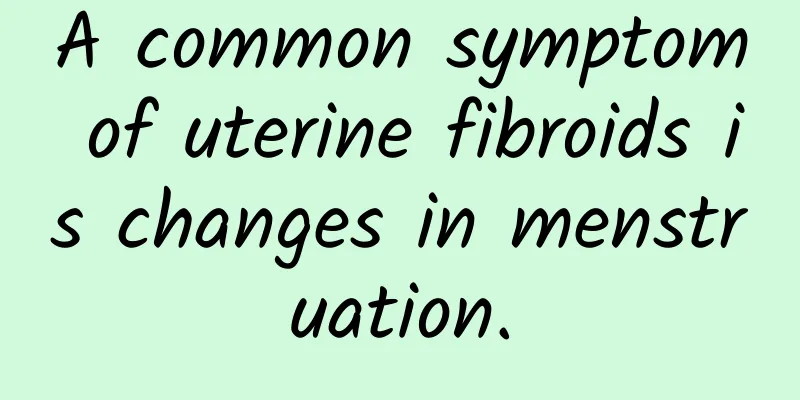What are the characteristics of malignant uterine fibroids? Can malignant uterine fibroids cause bleeding?

|
People know about uterine fibroids, right? There are many people suffering from this disease. Some are not easy to deteriorate, but some will have serious consequences. Everyone should pay attention to the appearance of disgusting tumors. Many people don’t know much about uterine fibroids, but there are many cases of uterine fibroids. What are the symptoms of malignant uterine fibroids? Vaginal secretions Pink, brown, watery or sticky, with a foul odor 2. Infertility and miscarriage 30% of patients with uterine fibroids are infertile. Infertility may be the reason for treatment, and uterine fibroids are found during examination. There are many reasons for infertility due to uterine fibroids, including uterine fibroids and pregnancy knots. Irregular vaginal bleeding Bleeding can occur at any time, except during hormone therapy. If a postmenopausal woman has vaginal bleeding similar to menstruation, it indicates the possibility of uterine cancer. Therefore, if there is abnormal vaginal bleeding or bleeding, you should go to the hospital for diagnosis and treatment as soon as possible. 4. Physical signs In women with a large gestational uterus, fibroids that are smaller than 3 months old are generally not easily palpable through the abdomen. 5. Weight loss, weakness, pain in the lower abdomen, back, and legs This happens when cancer metastasizes, or spreads. 6. Anemia Anemia can occur in patients with long-term bleeding but not treated in time. Before liberation, most working women were forced by life, and although uterine bleeding lasted for a long time, they could not be treated, leading to anemia. In the early days of liberation, the data of patients with uterine fibroids were as follows: 45% of patients had hemoglobin of 5 to 10 grams. 25%. 12% of patients had hemoglobin below 5 grams. 4%, mainly submucosal fibroids. Severe anemia (below 5 grams) can lead to anemic heart disease and myocardial degenerative changes. 7. Changes in the patient's general condition For example, nutrition, anemia, heart function, urinary system status, etc. are related to complications such as the duration of the disease and the amount of bleeding. 8. Hypertension Some patients with malignant uterine fibroids are accompanied by hypertension. According to statistics, most patients with hypertension (except those with a history of hypertension) return to normal after removing the fibroids, which may be related to the relief of ureteral compression. The above is a detailed description of today's experts. In order to prevent the disease from causing serious consequences to ourselves, we should pay attention to active diagnosis. Uterine fibroids are a very serious disease, and people need to understand the symptoms of this disease. Don't delay. Timely treatment is important. |
<<: What are the symptoms of uterine fibroids and how to treat uterine fibroids
Recommend
Drug treatment of abnormal leucorrhea
Medical treatment for abnormal leucorrhea: 1. Cha...
What are the main symptoms of irregular menstruation?
What we often call irregular menstruation is irre...
Experts analyze the main causes of pelvic inflammatory disease
Among many gynecological diseases, the incidence ...
What tests are needed for endometriosis?
What tests are needed for endometriosis? Women wi...
What to do if you have irregular menstruation? Here are 5 dietary methods to help you easily treat irregular menstruation
Irregular menstruation is one of the common gynec...
Symptoms of uterine adnexitis
Adnexitis is a type of gynecology, and uterine ad...
Ectopic pregnancy may be caused by appendicitis perforation
Ectopic pregnancy may be caused by appendicitis p...
What are the principles of medication in the treatment of Bartholinitis?
The main pathogens of Bartholinitis are Staphyloc...
Want to drink winter melon soup during menstruation? Drink it properly to nourish your body
It is very important for women to pay attention t...
3 different types of dietary supplements for functional uterine bleeding in adolescence
Dysfunctional uterine bleeding during puberty is ...
Typical symptoms of irregular menstruation
There are many things that happen during a woman&...
Early detection of early symptoms of pelvic inflammatory disease can help with treatment
Pelvic inflammatory disease can generally be divi...
What are the common symptoms of male pelvic effusion?
Male pelvic effusion refers to a condition in whi...
Expert introduction: Dysmenorrhea can be classified according to the degree of dysmenorrhea
Generally speaking, if we classify dysmenorrhea, ...
Ovarian cysts are harmful to women's health
Today's society is not only developing at a f...









